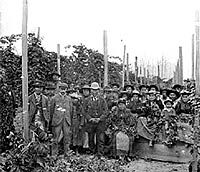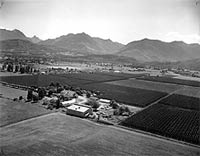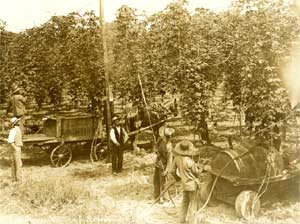
The object of the harvest is the hop cone. At the base of the brachts or brachiols are the lupulin glands, which are microscopic ice creamed cone, shaped glands. It is the more than 200 active essential oils in the lupulin glands that are used in the brewing process to provide beer with its taste, smell, foam; and flavour and physical stability. An 1894 article in the Chilliwack Progress worded it as "a pleasantly scented flower whose destiny it is to flavour the beverage that inebriates and causes much grief when taken in excess, but which, under the title of John Barleycorn, cheerers and enlivens when taken in moderation." (Sept. 26, 1894).
The soil of the Fraser Valley, alluvial deposits, with a rich top layer underlain by a layer of gravel, provided the type of drainage needed to keep the sensitive hop roots dry. Other than this condition, according to Rick Knight, a former manager at the Haas Hop Company the plant is not particularly fussy. The first attempts at hop growing in Sardis occurred around 1890. Theopholis Dumville and Adam Vedder were familiar with the work of three English growers in Agassiz who began experimenting with hop growing a few years earlier. However, they lacked familiarity with the needs of the crop and their attempts failed.
Henry Hulbert (1858-1931) was the first successful grower. Educated in England, Switzerland and Germany, this "aristocratic Englishman" became a tea tester and eventual owner of a tea and rubber plantation in Ceylon [Sri Lanka]. It is not clear why, but he left Ceylon in 1893 to travel back to England. His return journey took him to Vancouver where a visit with his brother-in-law, Dr. Duncan Bell-Irving, led him to the Fraser Valley. Impressed with what he saw, he purchased 50 acres of land in Sardis for a hop growing business. After his death, in 1931, his son, John, took over the business. However because of asthma he was unable to run the farm with any degree of success and the farm deteriorated. With John's death in 1944 the property was sold to the John I. Haas Company in 1944. This plot, located at the corner of Vedder and Higginson Road, operated as a hop farm until 1975.
E. Clemens Horst, a German born American, entered the business in 1902. Horst had worked as a hop merchant throughout the 1890s in New York but by 1902 had moved to San Francisco to develop his interests in fruit growing and canning. He purchased part of Adam Vedder's property in 1902 and within a few years owned over 300 acres of land in Sardis. This land was located in the Knight and Vedder Road vicinity. He expanded to Agassiz so that by 1912 his operation, the B.C. Hop Company, dominated the industry. Horst was content to remain in California leaving the operation of his yards to competent managers. Horst died in 1940. His land was sold to Haas on 1954 because of the "high cost of hand-picking plus lower priced American hops" (Chilliwack Progress, Sept. 22, 1954).
During the mid 1920s John I. Haas, an American hop broker, and another American, Harry Ord, who had worked at Horst's Oregon hop growing operations joined the industry. Ord and his partners purchased 600 acres of newly drained land on the former Sumas Lake bed while Haas purchased about 100 acres on Evans Road in Sardis. Prohibition in the United States opened up the Canadian market for the American hop brokers whose businesses had been devastated by prohibition.
Ord's death in 1956 resulted in the sale of his property to Haas in 1957. The consolidation of the industry in Sardis and Chilliwack was complete. Haas was now the only grower in the area. A combination of astute business practices and lack of heirs to take over the businesses that these unique entrepreneurs had started led to the industry's consolidation.
The last hop crop was harvested in Chilliwack in 1997. A few years earlier Fred Haas, the son of John I. Haas had died. His will stipulated that his property be willed to Georgetown University in Washington, D.C. The University sold this property and the former hop lands reverted to other farm uses. For more than 100 years, pickers would descend on Chilliwack for the yearly picking ritual. For generations of First Nations people, Japanese and Chinese workers, Mennonite families, East Asians and a host of other people, hop picking was a seasonal way of life.


Aerial view of the B.C. Golding Hop Yards, John I. Haas Hop Company, Sardis, B.C. ca. 1950s. Haas Collection.
Hop spraying on the Hulbert Hop Yards, Sardis, B.C. P1997.49
